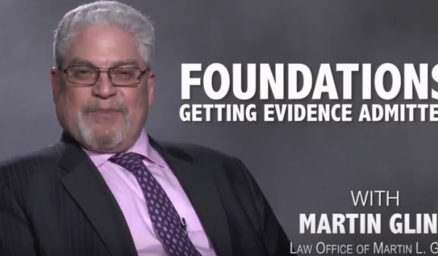Martin L. Glink, Featured in ISBA Professional Development Video
Posted: January 30, 2016

Partner and founder, Martin Glink of the Law Office of Martin L. Glink, is being featured in a helpful professional development video for the Illinois State Bar Association.
In the video, Martin discusses foundations for getting evidence admitted, including photos, business records, medical records, police reports, photos, etc.
In the video, he focuses on Illinois Supreme Court Rule 236, the Admission of Business Records in Evidence, which he says covers approximately 75 percent of what you will try to get into evidence. He suggests turning the rule into questions to get the record into evidence:
- Is this one of your business records of your company?
- Was this record made and kept in the regular course of business of your company?
- Was it the custom and practice of your company to make and keep this type of record in the ordinary course of business?
- At the time it was made, as far as anyone knows, was it accurate and made close in time to the event?
- And that’s how this record was specifically kept in the ordinary course of business?
He also discussed the exception to this rule, police reports. Martin explains in the video that you can get police reports into evidence by refreshing the police officer’s recollection by having him read the report or past recollection recorded. The Illinois Rules of Evidence will provide more guidance on these processes.
For photos, Martin explains that you only need to have the witness tell you that the photos truly and accurately show what they show (i.e. not doctored, airbrushed), then they go into evidence.
Martin reminds attorneys to always ask the judge for permission to publish the exhibit once they get it into evidence because the objective is for the fact finder (judge or jury) to see that evidence and use it when making their decision.
Lastly, Martin touches on demonstrative evidence. Demonstrative evidence, just like photos, needs to be accurate and help the jury understand the testimony of the witness or the evidence. Martin states that this is the only foundation you need to put in and the demonstrative evidence can be displayed before the jury after you ask the court for permission to publish.
If you or a loved one have been hurt or injured, it is important that you contact a qualified personal injury attorney as soon as possible. Contact the Law Office of Martin L Glink at 847-394-4900 today.





